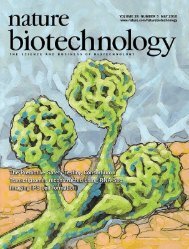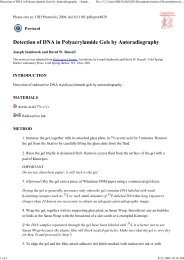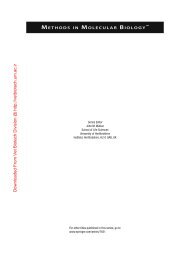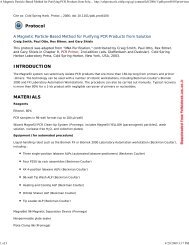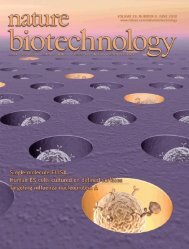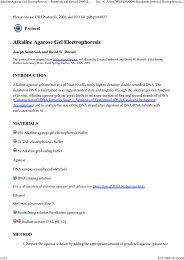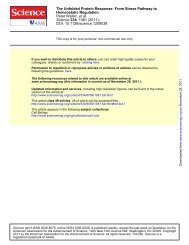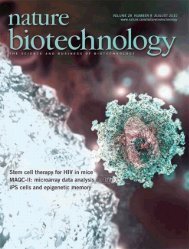B r i e f c o m m u n i c at i o n s© 2010 Nature America, Inc. All rights reserved.Enhanced antibody half-lifeimproves in vivo activityJonathan Zalevsky 1,3 , Aaron K Chamberlain 1 ,Holly M Horton 1 , Sher Karki 1 , Irene W L Leung 1 ,Thomas J Sproule 2 , Greg A Lazar 1 , Derry C Roopenian 2 &John R Desjarlais 1Improved affinity for the neonatal Fc receptor (FcRn) is knownto extend antibody half-life in vivo. However, this has neverbeen linked with enhanced therapeutic efficacy. We testedwhether antibodies with half-lives extended up to fivefold inhuman (h)FcRn transgenic mice and threefold in cynomolgusmonkeys retain efficacy at longer dosing intervals. We observedthat prolonged exposure due to FcRn-mediated enhancementof half-life improved antitumor activity of Fc-engineeredantibodies in an hFcRn/Rag1 –/– mouse model. This bridges thedemand for dosing convenience with the clinical necessity ofmaintaining efficacy.The well-established role of FcRn in IgG turnover has been the foundationfor Fc <strong>engineering</strong> efforts aimed at improving the pharmacokineticproperties of therapeutic antibodies 1,2 . Despite contraryresults about the relationship between FcRn affinity and half-life 3,4 ,several such efforts at pharmacokinetic <strong>engineering</strong> in nonhumanprimates, whose FcRn is similar to that of humans, have demonstratedthat engineered antibody variants have a prolonged half-life 5–8 . Yet,although the successful extension of half-life in pharmacokineticexperiments bodes well for the prospect of improving clinical dosing,a critical gap remains. For half-life extension technologies to beof practical use, efficacy of a biotherapeutic with longer half-life mustbe preserved at longer dosing intervals. Although the relationshipbetween drug exposure and efficacy is well-established, this correlationhas not thus far been established for antibodies engineered forlonger half-life.We coupled rational design methods with high-throughput proteinscreening to engineer a series of Fc variants with greater affinity forhuman FcRn. Variants were constructed in the context of the humanizedanti-vascular endothelial growth factor (VEGF) IgG1 antibodybevacizumab 9 (Avastin), which is currently approved for the treatmentof colorectal, lung, breast and renal cancers. A description of theconstruction, production and binding studies of the antibodies is providedin Supplementary Methods. As FcRn binds IgG at the lower pHof the early endosome (pH 6.0–6.5) but not at the higher pH of blood(pH 7.4), we used Biacore to screen antibodies for binding to humanFcRn at pH 6.0. Our engineered variants demonstrated between3- and 20-fold greater binding to FcRn at pH 6.0, with improvementsdue almost exclusively to slower off-rate (k off ) (Supplementary Fig. 1and Supplementary Table 1). A lead variant, M428L/N434S, subsequentlyselected principally based on its pharmacokinetic performance(see below), provided an 11-fold improvement in FcRnaffinity at pH 6.0. We refer to this double substitution in the context ofbevacizumab as Xtend-VEGF.Details of a pharmacokinetic study in cynomolgus monkeys(Macaca fascicularis) to evaluate the capacity of the variants toimprove serum half-life are provided in the Supplementary Methods.Binding improvements of the variants to monkey FcRn at pH 6.0were comparable to improvements for human FcRn, and the rankorder of the variants in FcRn affinity was the same (data not shown).When three monkeys per group were injected intravenously with4 mg/kg variant or native IgG1 anti-VEGF antibody, we observed alarge improvement in half-life for the variants relative to native IgG1(Supplementary Fig. 2a). Fitted parameters for the full set of variants(Supplementary Table 2) indicated increases in β-phase half-life, areaunder the curve (AUC) measurements and the rate of antibody clearancefrom serum. The observed 9.7-d half-life for native IgG1 bevacizumabagrees with the published value (9.3 d) for a slightly lower(2 mg/kg) dose 10 . Among the engineered antibodies that were tested,the Xtend double variant performed best (Fig. 1a). It prolonged halflifefrom 9.7 to 31.1 d, a 3.2-fold improvement in serum half-liferelative to native IgG1 (Supplementary Table 2). Simple allometricscaling extrapolations suggest that such improvement can potentiallytranslate into human half-lives >50 d.We then sought to further challenge the applicability of pharmacokinetic<strong>engineering</strong> by targeting an internalizing cell-surface antigenthat potentially provides a competing sink for antibody clearance.aConcentration (µg/ml)1001010.10 1020 30 40 50DaysXtend-VEGFIgG1 Bevacizumab60 70 80 90bConcentration (µg/ml)10010Xtend-EGFRIgG1 Cetuximab10 5 10 15 20DaysFigure 1 Increasing antibody affinity to FcRn promotes half-life extensionin cynomolgus monkeys. (a) Log-linear changes in serum concentrations foranti-VEGF (bevacizumab) antibodies in cynomolgus monkeys. All antibodieswere administered by single 60-min intravenous infusion at 4 mg/kg andserum antibody concentrations were determined using a VEGF antigendownimmunoassay. Results are means ± s.e.m. (n = 2 for bevacizumaband n = 3 for variants). (b) Log-linear changes in serum concentrations foranti-EGFR antibodies in cynomolgus monkeys. Monoclonal antibodies wereadministered by single 30-min intravenous infusion at 7.5 mg/kg and serumantibody concentrations were determined using an EGFR antigen-downimmunoassay. Results are means (n = 2 animals per test article).1 Xencor, Inc., Monrovia, California, USA. 2 The Jackson Laboratory, Bar Harbor, Maine, USA. 3 Present address: Takeda San Diego, Inc., San Diego, California, USA.Correspondence should be addressed to J.R.D. (jrd@xencor.com).Received 20 October 2009; accepted 14 December 2009; published online 17 January 2010; doi:10.1038/nbt.1601nature biotechnology volume 28 number 2 February 2010 157
i e f c o m m u n i c at i o n s© 2010 Nature America, Inc. All rights reserved.a100Concentration (µg/ml)cMean tumor volume (mm 3 )1010.1 Xtend-VEGFIgG1 Bevacizumab0 5 10 15 20DaysDay2565 751,200 Vehicle1,000 IgG1 BevacizumabXtend-VEGF800600400200035 45 55*85Concentration (µg/ml)Several studies have demonstrated that antibodies to epidermalgrowth factor receptor (EGFR) are internalized. Moreover, nonlineardose-dependent clearance has been observed in monkeys andhumans, leading to the hypothesis that receptor-dependent internalizationmakes a major contribution to clearance of anti-EGFRantibodies 11,12 . The M428L/N434S Xtend variant was constructed ina humanized version (huC225) of the anti-EGFR antibody cetuximab(C225) 13 (Erbitux), which is approved for the treatment of colorectaland head and neck cancers. We refer to this pharmacokineticallyenhanced anti-EGFR antibody as Xtend-EGFR. The improvementin affinity for human FcRn resembled that observed for anti-VEGF;binding to human EGFR antigen was unperturbed, and both cetuximaband humanized cetuximab cross-react with cynomolgus EGFR 14(data not shown). The 7.5 mg/kg dose chosen for this study is in arange where the dose-clearance relationship is nonlinear 14 . In ourhands cetuximab had a half-life of 1.5 d (Supplementary Table 2),similar to previously published data at the same dose (2.7–3.1 d) 14 .Consistent with the bevacizumab results, the Xtend variant anti-EGFR increased half-life to 4.7 d, reflecting a 3.1-fold improvement(Fig. 1b and Supplementary Table 2). We have thus demonstratedpharmacokinetic improvements conferred by Fc <strong>engineering</strong> of aninternalizing antibody, even when it is dosed within the nonlinearclearance regime.We performed pharmacokinetic experiments in C57BL/6J (B6)-background mice that are homozygous for a knockout allele of murineFcRn and heterozygous for a human FcRn transgene (mFcRn –/– ,bdMean tumor volume (mm 3 )1001010.10.01Xtend-EGFRIgG1 Cetuximab0 5 10 15 20DaysDay251,000Vehicle800 IgG1 CetuximabXtend-EGFR600400*200010 20 30 40Figure 2 Improved antibody half-life translates to greater in vivo efficacy.(a) Log-linear changes in serum concentrations of anti-VEGF antibodies inhFcRn mice. All antibodies were administered via single intravenous bolusat 2 mg/kg, and serum antibody concentrations were determined using ahuman immunoglobulin recognition immunoassay. Results are means± standard errors (n = 6). For some data points, errors are smaller than canbe indicated. (b) Log-linear changes in serum concentrations of anti-EGFRantibodies in hFcRn mice. The study design was identical to that describedin a, except that serum concentrations were measured with an EGFRantigen-down immunoassay. (c) Xenograft study in hFcRn/Rag1 –/– micecomparing activity of native IgG1 and Xtend variant versions of bevacizumabagainst established SKOV-3 tumors. Tumor volume is plotted against dayafter tumor cell injection. Antibodies were dosed at 5 mg/kg every 10 dstarting on day 35 (indicated by the arrows). n = 8 mice/group. *, P = 0.028at 84 d. (d) Xenograft study in hFcRn/Rag1 –/– mice comparing activity ofanti-EGFR antibodies against established A431 tumors. Tumor volume isplotted against day after tumor cell injection. Antibodies were dosed 5 mg/kgevery 10 d starting on day 10 (indicated by the arrows). n = 9 mice/group.*, P = 0.005 at 35 d.hFcRn + ) 15 , referred to here as hFcRn mice. A description of theseexperiments is provided in the Supplementary Methods. Serumconcentration data for native IgG1 and Xtend anti-VEGF antibodiesshowed a dramatic enhancement in half-life for the variant relativeto native IgG1 (Fig. 2a), improving half-life fourfold from ~3–12 d(Supplementary Table 2). In the anti-EGFR context, the Xtendvariant improved half-life to 13.9 d relative to 2.9 d for cetuximab,resulting in an enhancement of about fivefold (Fig. 2b andSupplementary Table 2). The IgG1 version of huC225 also had a relativelyshort half-life of 2 d (data not shown). We observed a generalcorrelation between antibody half-life and FcRn affinity at pH 6.0across two anti-VEGF studies and one anti-EGFR hFcRn pharmacokineticstudy. The pharmacokinetic results for individual variantsand native IgG1 were consistent and reproducible between the threestudies (Supplementary Fig. 2b–c and Supplementary Table 2).To test whether the slower clearance of our pharmacokineticengineeredantibodies results in improved exposure-related pharmacology,we developed an hFcRn transgenic, Rag1 –/– immunodeficientmouse strain (Supplementary Methods and Supplementary Fig. 3).For VEGF, SKOV-3 tumors were established to 25–60 mm 3 and thentreated with either vehicle or 5 mg/kg native IgG1 or Xtend variantbevacizumab every 10 d. This dosing schedule approximated the halflifeof the Xtend variant, but was three to four half-lives longer thanthe half-life of the native IgG1 version (Supplementary Table 2). Astatistically greater level of tumor reduction (P = 0.028 at study termination)was observed for the Xtend variant relative to the native IgG1version (Fig. 2c). A similar study in hFcRn/Rag1 –/– mice comparingXtend-EGFR to a native IgG1 version showed similar improvementsin tumor reduction (P = 0.005) against established A431 epidermoidcarcinoma tumors (Fig. 2d). Consistent with the pharmacokineticresults in hFcRn mice (Fig. 2a–b), the variants reduced clearance inthe hFcRn/Rag1 –/– mice (Supplementary Fig. 3a–b), demonstratingan inverse correlation between tumor volume and serum concentrationof antibody at study termination. These results indicate that theslower clearance of the variant antibodies leads to higher drugexposure and consequently superior tumor-suppressing pharmacology.Additional studies comparing various dosing intervals of theXtend variants and parent antibodies will be necessary to preciselydefine dosing regimens for optimal clinical benefit. However, theresults described here firmly establish a positive correlation betweenpharmacokinetic enhancement and in vivo efficacy.Despite the reasonably long half-lives of monoclonal antibodies,market pressures for higher patient convenience and compliance continueto drive antibody drug programs toward less frequent dosingschedules. Yet, because of the potential loss in efficacy when the dosingfrequency is not justified by the pharmacokinetics of the drug, thecritical issue of whether slower antibody clearance through Fc <strong>engineering</strong>leads to superior exposure-dependent efficacy has remainedunresolved. Our results indicate that, for at least some therapies,efficacy can be preserved with extended dosing intervals enabled bypharmacokinetic <strong>engineering</strong>. This work thus paves the way for a newgeneration of antibody therapies and biologically superior versions ofapproved antibody drugs that deliver finer control over dosing whileproviding greater convenience to patients.Note: Supplementary information is available on the Nature Biotechnology website.AcknowledgmentsWe thank The Jackson Laboratory JAX West and SNBL USA for carrying outpharmacokinetic experiments, B. Dahiyat for helpful discussions, andA. Eivazi, D.-H.T. Nguyen, H. Herman, J.M. Jacinto and U.S. Muchhal fortechnical contributions.158 VOLUME 28 NUMBER 2 FEBRUARY 2010 nature biotechnology
- Page 3 and 4:
volume 28 number 2 february 2010COM
- Page 5 and 6:
in this issue© 2010 Nature America
- Page 7 and 8:
© 2010 Nature America, Inc. All ri
- Page 10 and 11:
NEWS© 2010 Nature America, Inc. Al
- Page 12 and 13:
NEWS© 2010 Nature America, Inc. Al
- Page 14 and 15: NEWS© 2010 Nature America, Inc. Al
- Page 16 and 17: © 2010 Nature America, Inc. All ri
- Page 18 and 19: © 2010 Nature America, Inc. All ri
- Page 20 and 21: © 2010 Nature America, Inc. All ri
- Page 22 and 23: NEWS feature© 2010 Nature America,
- Page 24 and 25: uilding a businessComing to termsDa
- Page 26 and 27: uilding a business© 2010 Nature Am
- Page 28 and 29: correspondence© 2010 Nature Americ
- Page 30 and 31: correspondence© 2010 Nature Americ
- Page 32 and 33: correspondence© 2010 Nature Americ
- Page 34 and 35: correspondence© 2010 Nature Americ
- Page 36 and 37: case studyNever againcommentaryChri
- Page 38 and 39: COMMENTARY© 2010 Nature America, I
- Page 40 and 41: COMMENTARY© 2010 Nature America, I
- Page 42 and 43: patents© 2010 Nature America, Inc.
- Page 44 and 45: patents© 2010 Nature America, Inc.
- Page 46 and 47: news and viewsChIPs and regulatory
- Page 48 and 49: news and viewsFrom genomics to crop
- Page 50 and 51: news and views© 2010 Nature Americ
- Page 52 and 53: news and views© 2010 Nature Americ
- Page 54 and 55: e s o u r c eRational association o
- Page 56 and 57: e s o u r c e© 2010 Nature America
- Page 58 and 59: e s o u r c e© 2010 Nature America
- Page 60 and 61: e s o u r c e© 2010 Nature America
- Page 62 and 63: © 2010 Nature America, Inc. All ri
- Page 66 and 67: i e f c o m m u n i c at i o n sAUT
- Page 68 and 69: lettersa1.5 kb hVPrIntron 112.5 kbA
- Page 70 and 71: letters© 2010 Nature America, Inc.
- Page 72 and 73: letters© 2010 Nature America, Inc.
- Page 74 and 75: l e t t e r sReal-time imaging of h
- Page 76 and 77: l e t t e r sFigure 2 Time-lapse li
- Page 78 and 79: l e t t e r s© 2010 Nature America
- Page 80 and 81: l e t t e r sRational design of cat
- Page 82 and 83: l e t t e r s© 2010 Nature America
- Page 84 and 85: l e t t e r s© 2010 Nature America
- Page 86 and 87: sample fluorescence was measured as
- Page 88 and 89: careers and recruitmentFourth quart




